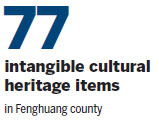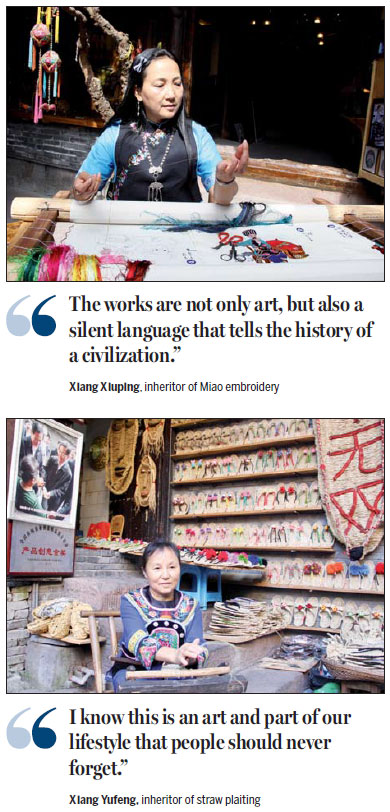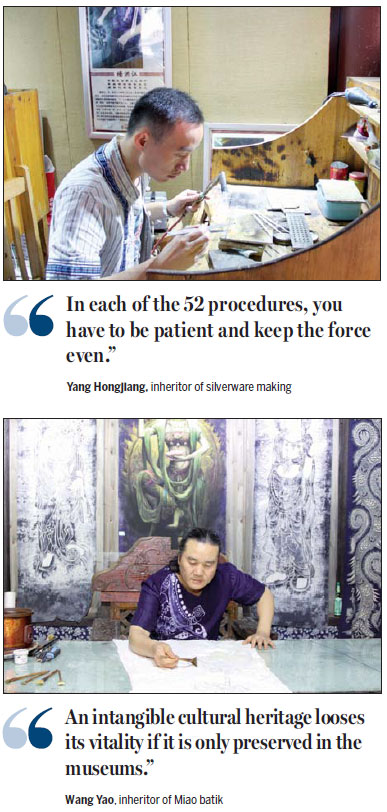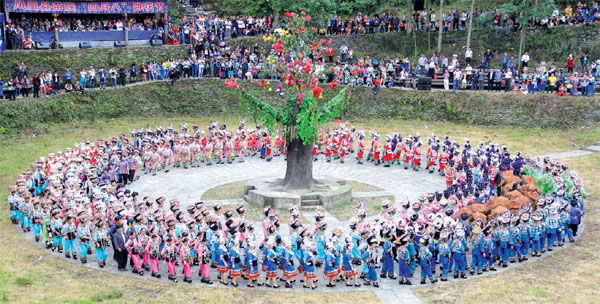Taking traditional skills into the future
|
Miao ethnic people in traditional dress dance at Yanu Festival in Fenghuang. Photos by Wu Wenxing from Fenghuang County Publicity Department |
Editor's note: Inheritors of many intangible cultural heritage items in Fenghuang county, Hunan province, not only practice what their ancestors passed down but also innovate and develop new products to meet consumer demands. Some shared their stories of years of effort to learn and promote their skills with China Daily reporter Zhang Zhao.
Xiang Xiuping - Miao embroidery
When Xiang Xiuping was a little girl, she lived beside a road that local Miao ethnic people traveled on to go to the market, and noticed how beautiful and delicate their traditional clothes were. Since then, she has been interested in Miao embroidery, although she belongs to the Tujia ethnic group.
She began collecting Miao embroidery pieces in 1996. After she was laid off from a tobacco factory in 2000, she opened an embroidery workshop that employed other laid-off workers.
During the past decade, she has worked managing companies, storehouses and restaurants, and used nearly all her earnings to buy embroidery for her collection.
"The works are not only art, but also a silent language that tells the history of a civilization," she said.
Xiang owns a shop in the old town of Fenghuang that sells and displays Miao embroidery. It has traditional Miao costumes, art pendants, toys and clothes combining traditional embroidery skills and modern designs.
The star piece in the shop is a 148-meter-long embroidery finished in March 2013. It was designed by Xiang and took 48 women, including Xiang, 26 months to complete.
The work shows an old man in a Miao village telling stories of the ethnic group's history from the prehistoric age until today. Xiang spent about 10 years collecting the stories.
Yang Hongjiang - Silverware
At only 27 years of age, Yang Hongjiang is already an expert in the Miao style of silverware making.
He started to learn the skill when he was seven, first from his father and then from other masters, and became a professional when he was 15.

Yang said similar skills are seldom seen elsewhere, and he would like to promote the handicraft nationwide.
A commonly used technique in Miao silverware is coiling thin silver wires to form shapes or patterns. A technician uses a mold with 52 holes of different diameters to process silver ingots into wires as thin as hairs, step by step.
"In each of the 52 procedures, you have to be patient and keep the force even - not too hard or too sudden," said Yang, adding that another of the difficulties in the traditional skill is to keep the welding temperature between 950 and 1000 C.
Even though a master, Yang sometimes has to start over again if he makes a mistake.
A bracelet usually takes him two days to finish. He does not need a design on paper, for he carries all the patterns in his mind.
Traditionally, Miao silverware was used as jewelry, but Yang and his co-workers have developed new products, such as tea sets and dinner sets, which are as popular with tourists as the traditional bracelets and necklaces.
Xiang Yufeng - Straw plaiting
Xiang Yufeng asked for nothing as a dowry when she married, except a machine to make straw shoes. At 61 years of age, she is still using the same machine.
She said the basic patterns are firmly in her mind. "I can make shoes even with my eyes closed," she said.
Xiang has a straw handicraft shop in the old town of Fenghuang with a plaque that reads "King of Straw Shoes" written by famous calligrapher Huang Yongyu.
Her business was not good between 2006 and 2008. "Some people laughed at me, and I sometimes thought about giving up, but I couldn't. I know this is an art and part of our lifestyle that people should never forget," she said. "I believe I can make a difference."
She can make more than 100 different shoe patterns, some of which are modern styles. Based on the skills she learned making shoes, she has also developed other handicrafts.
"I'm a skilled worker but not a good designer," Xiang said, adding that her brother helps her design large pieces plaited from straw, some of which have won awards at domestic handicraft exhibitions.
Wang Yao - Miao batik
Wang Yao was born in Guizhou province and went to Fenghuang in 2006.
"Fenghuang is a place that gives me inner peace and the local people are very tolerant, so I can create my own works," he said.
His grandfather owned a dyeing business, where Wang became interested in batik, a similar technique, some 30 years ago.
Traditional Miao batik patterns are mostly dots and curved lines, but Wang uses more complex designs with new themes and elements, such as Buddhism and Chinese painting.
"An intangible cultural heritage looses its vitality if it is only preserved in the museums," he said. "The market brings it fresh blood."
He designed a series of qipao (a traditional Chinese dress for women) using batik technique, and said he wants to develop a series of blue clothes as popular as blue denim jeans.
"Ethnic culture can be fashionable," he said.
Wang has also improved the dye formula to reduce the dyeing process from one day to less than 10 minutes, so tourists can try the technique themselves.
Contact the writer at zhangzhao@chinadaily.com.cn.


(China Daily 10/22/2015 page15)









